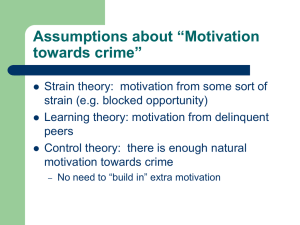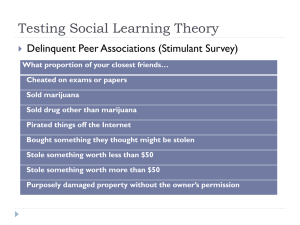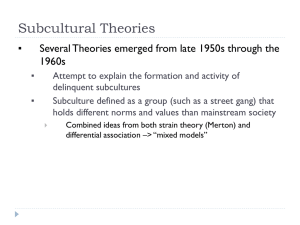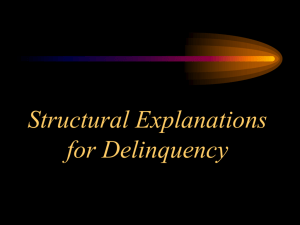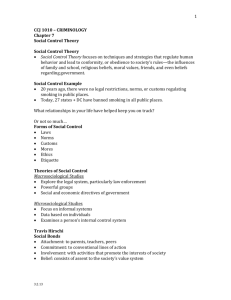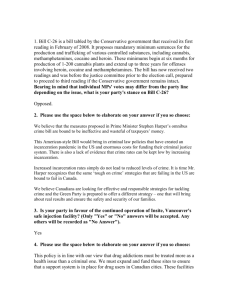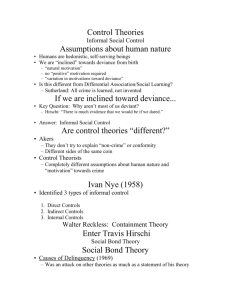Social Process II (Informal Control)
advertisement
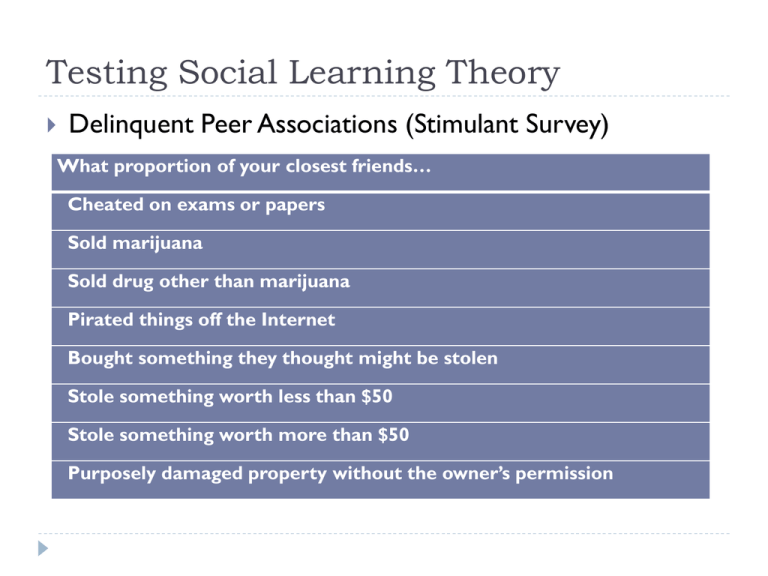
Testing Social Learning Theory Delinquent Peer Associations (Stimulant Survey) What proportion of your closest friends… Cheated on exams or papers Sold marijuana Sold drug other than marijuana Pirated things off the Internet Bought something they thought might be stolen Stole something worth less than $50 Stole something worth more than $50 Purposely damaged property without the owner’s permission Survey Says… Delinquent Peer correlates moderately with… Illicit stimulant use ever (.25) and in the past year (.15) Marijuana use in past year (.35) Academic fraud (.38) Deviance/Crime (.49) Binge drinking (.29) Testing Social Learning Theory Moral Beliefs (Definitions) How wrong is it to… Cheat on exams or papers Sell marijuana Sell drug other than marijuana Pirate things off the Internet Buy something they thought might be stolen Steal something worth less than $50 Steal something worth more than $50 Purposely damage property without the owner’s permission Survey Says… Moral beliefs correlates moderately with… Illicit stimulant use ever (.27) and in the past year (.22) Marijuana use in past year (.39) Academic fraud (.21) Deviance/Crime (.44) Binge drinking (.29) Subcultural Theories Several Theories emerged from late 1950s through the 1960s ▪ Attempt to explain the formation and activity of delinquent subcultures Subculture defined as a group (such as a street gang) that holds different norms and values than mainstream society ▪ ▪ Combined ideas from both strain theory (Merton) and differential association (Sutherland) –> “mixed models” Specific Subcultural Theories 1. Status frustration (Cohen) 2. Differential opportunity theory (Cloward and Ohlin) 3. Focal concerns of the lower class (Miller) In the interests of time and student sanity, we’ll just discuss Cloward and Ohlin as one example. This will be the only one to appear on the exam. Differential Opportunity Theory Richard Cloward and Lloyd Ohlin ▪ From Merton: Lack of legitimate opportunities for success causes strain ▪ ▪ ▪ Blocked economic aspirations lead to poor self-image Frustration leads to delinquency From Sutherland: much delinquency requires access to “illegitimate means” for success Delinquents learn criminal trades within neighborhood Differential Opportunity Theory (2 of 2) Delinquent subcultures ▪ Criminal subculture ▪ ▪ Where illegitimate opportunities exist, delinquents seek economic gain, view crime as a career Conflict subculture ▪ ▪ Where no illegitimate opportunities exist, gangs fight over turf and place high value on violence Retreatist subculture ▪ ▪ “Double losers”: Emphasizes drug abuse or other forms of escape Subcultural Theory Criticism ▪ Narrow scope ▪ ▪ ▪ ▪ Focus on lower-class boys Does not account for white-collar crime, middle-class crime, or female offending Are gangs are truly subcultures? Assumes almost perfect socialization to gang Control Theories Control = shorthand for informal social control Theories covered Hirschi (social bonds) Gottfredson and Hirschi (low self-control) Sampson and Laub (age graded social control) Assumptions about “Motivation towards crime” Strain theory: motivation from some sort of strain (e.g. blocked opportunity) Learning theory: motivation from delinquent peers Control theory: there is enough natural motivation towards crime No need to “build in” extra motivation Real question? Why aren’t we all criminal? Types of Control Direct Control Indirect Control Direct punishments, rewards from parents, friends Refrain from deviance because you don’t want to risk friends, job, etc. Internal Control Good self-concept, self-control, conscience Walter Reckless’ Containment Theory as precursor to “control” theories Inner Containment (Good self concept) Outer Containment •parents/school •supervision Pushes and Pulls • poverty, anger,delinquent subculture DELINQUENCY OUT HERE !!!!!! ENTER TRAVIS HIRSCHI Causes of Delinquency (1969) Was an attack on other theories as much as a statement of his theory Self-report data (CA high schools) Measures from “competing theories” This book was the first of its kind! Social Bond Theory “Bond” indicates “Indirect Control” Direct controls (punishment, reinforcement) less important because delinquency occurs when out of parents’ reach (adolescence). Attachment Commitment Involvement Belief (Elements of the social bond are all related to each other) Or, Put Another Way… The Social Bond Attachment Commitment Involvement Belief Crime Fun, thrilling, quick and easy satisfaction of desires Hirschi’s Evidence in Favor of Bonds Attachment Commitment Attachment to parents (wish to emulate, identify with) Grades, educational aspirations Belief Techniques of Neutralizations Criticisms of Hirschi’s Theory 1. 2. 3. 4. Delinquents do form relationships Attachment to delinquent peers or parents increases, rather than decreases delinquency Which comes first, bonds or delinquency? Bonds more salient for females, and early in adolescence Gottfredson and Hirschi (1990) A General Theory of Crime Same control theory assumptions If we are all inclined to be deviant, why conform? Because most of us develop “self-control” “Internal control” Developed by age 8, as the result of “direct control” from parents Nature of Crime, Nature of Low Self-Control Criminal Acts… People with low self-control are therefore… Provide immediate gratification of desires Impulsive Are risky/thrilling Are easy/simple Require little skill/planning Risk-taking Physical (as opposed to mental) Low verbal ability Provide few/meager long term benefits Short-sighted Result in pain/discomfort to a victim Insensitive The implications of low self-control Explains “stability of criminal behavior” But, how does it explain “aging out?” Explains all crime and analogous behaviors Analogous = same “nature” as criminal acts Empirical Support Moderate relationship between low self-control and both crime and analogous behaviors Holds for both males and females BUT Not the “sole cause” of crime May not explain white collar crime at all Stimulant Survey and LSC How much do you agree wit h the following…. I am good at resisting temptationg I have a hard time breaking bad habits I am lazy I say inappropriate things I do certain things that are bad for me if they are fun I refuse things that are bad for meg I wish I had more self-discipline People would say that I have iron self-disciplineg Pleasure and fun sometimes keep me from getting work done I have trouble concentrating I am able to work effectively toward long-term goalsg Sometimes I can’t stop myself from doing something, even if I know it is wrong Survey Says… Low Self-Control predicted (fairly well) Illicit stimulant use ever (.25) and in the past year (.19) Marijuana use in past year (.33) Academic fraud (.22) Deviance/Crime (.41) Binge drinking (.33) “Age Graded Theory of Informal Social Control” Sampson and Laub We will cover this again in the “lifecourse” theory section Takes Hirschi’s (1969) theory and made it “age graded” The specific elements of the social bond change over the life-course Also includes elements of “direct control” Also throws in some other stuff (integrated theory) Sampson and Laub Childhood Context Individual Differences Adolescence Parenting • Supervision • Discipline Social Bonds • Family • School Delinquent Peers Delinquency Length of Incarceration Adulthood Adult Crime Social Bonds •Marriage •Good Job Policy Implications Hirschi’s Social Bond Theory Gottfredson and Hirschi’s General Theory Target attachment, commitment, belief Must focus on early childhood prevention Train parents? Sampson and Laub Different targets for different ages Importance of adult bonds (job, marriage)
